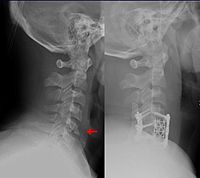
Photo from wikipedia
STUDY DESIGN Post-hoc analysis of a prospective, multi-center cohort study. OBJECTIVE To analyze the impact of smoking on rates of postoperative adverse events (AEs) in patients undergoing high-risk adult spine… Click to show full abstract
STUDY DESIGN Post-hoc analysis of a prospective, multi-center cohort study. OBJECTIVE To analyze the impact of smoking on rates of postoperative adverse events (AEs) in patients undergoing high-risk adult spine deformity surgery. SUMMARY OF BACKGROUND DATA Smoking is a known predictor of medical complications after adult deformity surgery, but the effect on complications, implant failure and other AEs has not been adequately described in prospective studies. METHODS Twenty-six patients with a history of current smoking were identified out of the 272 patients enrolled in the SCOLI-RISK-1 study who underwent complex adult spinal deformity surgery at 15 centers, with 2 year follow up. The outcomes and incidence of AEs in these patients were compared to the non-smoking cohort (n = 244) using univariate analysis, with additional multivariate regression to adjust for the effect of patient demographics, complexity of surgery and other confounders. RESULTS The number of levels and complexity of surgery in both cohorts were comparable. In the univariate analysis, the rates of implant failure were almost double (Odds Ratio 2.28 [0.75-6.18]) in smoking group (n = 7; 26.9%)) that observed in the non-smoking group (n = 34; 13.9%), but this was not statistically significant (p = 0.088). Surgery-related excessive bleeding (>4 liters) was significantly higher in the smoking group (n = 5 vs n = 9; 19.2% vs 3.7%; OR 6.22[1.48 - 22.75]; p = 0.006). Wound infection rates and respiratory complications were similar in both groups. In the multivariate analysis, the smoking group demonstrated a higher incidence of any surgery-related AEs over 2 years (n = 13 vs n = 95; 50.0% vs 38.9%; OR 2.12 [0.88-5.09]) (p = 0.094). CONCLUSION In this secondary analysis of patients from the SCOLI-RISK-1 study, a history of smoking significantly increased the risk of excessive intra-operative bleeding and non-significantly increased the rate of implant failure or surgery-related AEs over 2 years. The authors therefore advocate a smoking cessation program in patients undergoing complex adult spine deformity surgery. LEVEL OF EVIDENCE 2.
Journal Title: Spine
Year Published: 2019
Link to full text (if available)
Share on Social Media: Sign Up to like & get
recommendations!